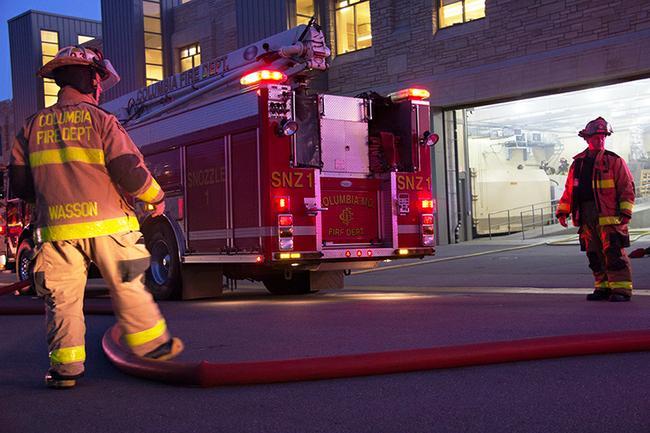
As MU buildings are remodeled and the campus continues to grow, so do the fire safety measures used to protect students.
Shawn McCollom, assistant fire marshal for the Columbia Fire Department, said as new buildings are constructed, automatic sprinklers and alarms are also being installed. The small number of existing buildings that don’t already contain these devices will eventually have them added on.
“What we’re doing is we are going through the entire campus,” McCollum said. “As we do remodeling projects, those (fire) systems are put in there. They are required for current (building) codes.”
The MU Student Center has been standing for two years now, and only once did it have to go through the motions of an emergency fire evacuation. In May, a fire started inside a trash compactor in the loading dock of the student center and students were forced to exit the building as the Columbia Fire Department arrived to put out the flames. The fire did not grow large enough to do any damage to the building.
The student center is more than prepared for an unexpected blaze, said McCollom, who works with MU’s Department of Environmental Health and Safety.
“The student center has a fully automatic fire alarm and sprinkler system,” McCollum said. “Along with the restaurants inside of there, which have automatic fire extinguishing systems over the cooking areas.”
The systems can be found at the student center and throughout campus in a majority of the buildings, McCollum said. When triggered, these systems immediately contact the emergency hotline.
“The fire alarm systems on the campus of the University of Missouri are automatically dispatched to MUPD,” McCollum said. “MUPD then automatically calls joint communications, the 911 center in the city of Columbia, who then dispatches the fire department. So, it’s a very quick process.”
Education is essential to fire safety in general, McCollum said . He said faculty, staff members and students are taught what to do when these fire alarm systems go off and what men like McCollum do in these situations.
One of the largest providers of this fire safety education in Missouri is the [MU Extension Fire and Rescue Training Institute](http://mufrti.org).
“Utilizing an extensive system of instructional outreach, (MU Extension Fire and Rescue Training) assists fire departments, agencies, and organizations in meeting complex public protection challenges and training issues,” the website states. “This outreach initiative takes the training programs directly into local communities throughout the state and provides training and education, which are otherwise unavailable.”
About 90 percent of the firefighters in the state are volunteers, said David Hedrick, MU Fire and Rescue Training Institute spokesman.
“We direct our focus on training firefighters and other emergency responders in the state,” Hedrick said. “We spend a lot of time with volunteers because there is such a high percentage of them. Because people have other jobs, a lot of our training is spent during the night and on weekends and delivered to an outreach mission across the state.”
Hedrick said some training takes place on campus, but the majority of the training is done out across the state.
“You can find us teaching anywhere in the state,” Hedrick said. “We touched all 114 counties in the state last year through instructional activity, and we trained over 17,000 firefighters in the state.”
The MU Extension Fire and Rescue Training Institute teaches both basic and specialized firefighting classes.
“In basic training, we teach them how to use the hose lines, attack fire and those kind of things,” Hedrick said. “In specialized training, we do vehicle extrication training. If there was a car accident, we teach them how to respond and get people out of cars.”
Hedrick said the training institute is very proud of the fact it has been an MU program for 80 years now and a credited institute for 30.
“We have a great staff, a great group of people and a lot of hardworking individuals,” Hedrick said.